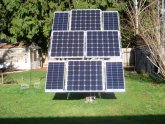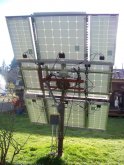Mark MacDonald
New Member
- Joined
- Dec 17, 2019
- Messages
- 3
What if there was a technology that could increase solar panel output by nearly 50%? Everyone would be super excited. Oh, there already is a technology that does that: solar tracking.
We've all seen the fields of commercial arrays with solar trackers following the sun, some dual-axis, most single, and yet outside of the utility scale applications common wisdom presumes that solar tracking is too much trouble and it's better to just buy as many PV panels as you can..
I'd like to explore the issue a bit deeper and present some of the positive considerations for application of solar tracking for residential/off-grid applications and common rebuttals in favor of fixed mount arrays (in a somewhat sarcastic manner, hopefully for your amusement).
Pro #1. The big obvious: get more power. Up to nearly 50% more with dual-axis under ideal conditions. The power curve is much more flat like a mesa top instead of a camel hump as well. If you're grid-tied, then your utility thanks you for the wider power curve, and if you're off-grid, then your batteries thank you for the extra float time before you start discharging them again.
Rebuttal:
Under cloudy conditions solar tracking can be useless. Me buy more panels. More better.
2n'd affirmative: Forgive me, but I consider this the brute force and ignorance approach.
Solar panels can be useless under cloudy conditions, that's not a rebuttal! Tracking still benefits from the sunny times. In fact, it makes the good times better. A very common weather pattern is a cloudy day that finally clears up in the late afternoon. Fixed PV panels will sit at an inefficient angle, but a solar tracker can easily deliver twice the wattage in these conditions and might be able to actually quickly float your batteries with those last hours of sun.
Also up for consideration is the available area for roof mounting of PV panels which could limit the ability to simply add more panels. Certainly this is not a given.
2. Incremental cost increase for ground mounted arrays for solar tracking can be a negligible project percentage compared to performance increase.
It's illogical to just compare the PV panel costs when calculating power, much less ROI. Assuming for the sake of this point that we don't address roof mounted panels, the construction materials and labor for footings, trenching for cables, assembly and installation of a fixed mounting system and PV panels requires only minor expenses to allow for movable joints and electro-mechanical hardware to perform solar tracking.
Rebuttal:
Yeah, but it's still complicated and can be unreliable, better to just use more PV panels
2n'd Aff: It is true that not everyone is qualified to engineer a tracking system, and even trying to install an engineered system can be bewildering to those without experience with electronics, motors, and DC as well as AC electricity utilization; however, this is all solved by research and educations, as well as utilization of qualified personnel and equipment, as with all things.
Additionally laying more panels is all fine and dandy in flat desert or open plains, but lots of people (outside of the cities) live in wooded and mountainous area where the roof of your house might not even be the part of the property that gets the most sunlight (ever live in the redwoods?). In those case you may need to maximize the production you can get from the area that does get sunlight and a solar tracker is ideal for that.
3. Roof mounted systems may not be feasible for existing structures, and also pose a number of issues including fire hazard.
A ground mounted solar tracker eliminates any structural or mounting issues with existing roofing systems, and by situating the solar panels in off the ground in a clear open area (for sunlight exposure) fire-hazard is also greatly reduced.
Rebuttal: Fire hazard is low enough you don't have to worry about that, and who cares about solar for houses with funny pitches and roof types?
2n'd Aff: Um, yeah, ok.
4. Renters may not be able to get permission, or want to place pv panels on a roof. Tracking mounts can be disassembled and moved, or even built on trailers for ultimate mobility and utility.
Rebuttal: I own my home and I don't care about that, it still sounds hard anyway.
2'nd Aff: But it's a great option for those that need it, and could also apply to Tiny House owners and RV'ers as well.
5. It's a freaking robot! It sleeps at night, wakes up in the morning, follows the sun, and collects power for your house...how cool is that?
Do you by clothes, cars, phones, or most of the other things in life without considering how they make you feel?
If you have a solar tracker system, guests will want to see it, and you will want to show it to them. You will feel pride of ownership.
If you have passive panels on your roof, you'll probably forget to talk, or even think about them.
Rebuttal: Silly nerds.
2'nd Aff: Long live the nerds.
Check out homecsp.com for more information about solar tracking and my line of solar tracking controllers .
We've all seen the fields of commercial arrays with solar trackers following the sun, some dual-axis, most single, and yet outside of the utility scale applications common wisdom presumes that solar tracking is too much trouble and it's better to just buy as many PV panels as you can..
I'd like to explore the issue a bit deeper and present some of the positive considerations for application of solar tracking for residential/off-grid applications and common rebuttals in favor of fixed mount arrays (in a somewhat sarcastic manner, hopefully for your amusement).
Pro #1. The big obvious: get more power. Up to nearly 50% more with dual-axis under ideal conditions. The power curve is much more flat like a mesa top instead of a camel hump as well. If you're grid-tied, then your utility thanks you for the wider power curve, and if you're off-grid, then your batteries thank you for the extra float time before you start discharging them again.
Rebuttal:
Under cloudy conditions solar tracking can be useless. Me buy more panels. More better.
2n'd affirmative: Forgive me, but I consider this the brute force and ignorance approach.
Solar panels can be useless under cloudy conditions, that's not a rebuttal! Tracking still benefits from the sunny times. In fact, it makes the good times better. A very common weather pattern is a cloudy day that finally clears up in the late afternoon. Fixed PV panels will sit at an inefficient angle, but a solar tracker can easily deliver twice the wattage in these conditions and might be able to actually quickly float your batteries with those last hours of sun.
Also up for consideration is the available area for roof mounting of PV panels which could limit the ability to simply add more panels. Certainly this is not a given.
2. Incremental cost increase for ground mounted arrays for solar tracking can be a negligible project percentage compared to performance increase.
It's illogical to just compare the PV panel costs when calculating power, much less ROI. Assuming for the sake of this point that we don't address roof mounted panels, the construction materials and labor for footings, trenching for cables, assembly and installation of a fixed mounting system and PV panels requires only minor expenses to allow for movable joints and electro-mechanical hardware to perform solar tracking.
Rebuttal:
Yeah, but it's still complicated and can be unreliable, better to just use more PV panels
2n'd Aff: It is true that not everyone is qualified to engineer a tracking system, and even trying to install an engineered system can be bewildering to those without experience with electronics, motors, and DC as well as AC electricity utilization; however, this is all solved by research and educations, as well as utilization of qualified personnel and equipment, as with all things.
Additionally laying more panels is all fine and dandy in flat desert or open plains, but lots of people (outside of the cities) live in wooded and mountainous area where the roof of your house might not even be the part of the property that gets the most sunlight (ever live in the redwoods?). In those case you may need to maximize the production you can get from the area that does get sunlight and a solar tracker is ideal for that.
3. Roof mounted systems may not be feasible for existing structures, and also pose a number of issues including fire hazard.
A ground mounted solar tracker eliminates any structural or mounting issues with existing roofing systems, and by situating the solar panels in off the ground in a clear open area (for sunlight exposure) fire-hazard is also greatly reduced.
Rebuttal: Fire hazard is low enough you don't have to worry about that, and who cares about solar for houses with funny pitches and roof types?
2n'd Aff: Um, yeah, ok.
4. Renters may not be able to get permission, or want to place pv panels on a roof. Tracking mounts can be disassembled and moved, or even built on trailers for ultimate mobility and utility.
Rebuttal: I own my home and I don't care about that, it still sounds hard anyway.
2'nd Aff: But it's a great option for those that need it, and could also apply to Tiny House owners and RV'ers as well.
5. It's a freaking robot! It sleeps at night, wakes up in the morning, follows the sun, and collects power for your house...how cool is that?
Do you by clothes, cars, phones, or most of the other things in life without considering how they make you feel?
If you have a solar tracker system, guests will want to see it, and you will want to show it to them. You will feel pride of ownership.
If you have passive panels on your roof, you'll probably forget to talk, or even think about them.
Rebuttal: Silly nerds.
2'nd Aff: Long live the nerds.
Check out homecsp.com for more information about solar tracking and my line of solar tracking controllers .




